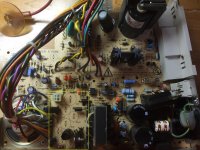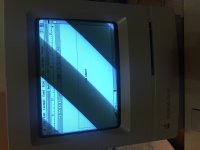SlateBlue
Well-known member
Hi everyone. I thought I'd take the time to create a post about my recapping adventure, and maybe take the opportunity to ask a few questions. If the is dry reading for you, I apologize. I'm not known for being a good storyteller.
So, for starters - A several months ago, I acquired a Macintosh SE and a Macintosh Classic. The SE appeared to work just fine (still has original caps on board), and was in overall good condition with minimal yellowing. The Classic would boot fine, but had no sound, and the case had significant yellowing. I removed the logic board from the Classic to find that all the SMD caps were leaking. I set the SE aside and went to work on the Classic. After a botched repair attempt (a couple of lifted pads), I sent the board to Novi, Michigan for a professional recap job. The recap fixed the sound issue, but I still had yet to tackle the cosmetic issues of the machine. Pressed for time on other projects, I set the Mac Classic aside to be worked on at a later date.
Last week, I finally took the time to completely disassemble the Mac Classic so I could retrobright the front bezel and rear case. I also took the time to blow compressed air over the AB to remove years of dust. Upon reassembling the computer and powering it on, it seemed the hard drive would quite spin up. It would try, and with each attempt the screen would flicker. Thinking I had a bad hard drive (it worked weeks prior), I swapped a known good working one to find that the issue persisted. I then realized I likely was dealing with a voltage issue. I measured both +5v and +12v at the external floppy port and realized the voltage readings were low ~ around +4.8 and +11.65 respectively. So, I adjusted PP1 until both voltages were in an acceptable range ~ +5.05 and +11.99. I suspected that the compressed air had somehow turned the potentiometer and decreased the voltage.
Yesterday, after cleaning the floppy drive, I noticed the screen would appear to shake/wave slightly as the disk drive was working. Thinking again that I had a voltage issue, I measured at the external floppy port again. The voltages were ~ +5.15 and +11.77. At this point, I realized adjusting PP1 wouldn't fix the issue. Too little voltage is worse than too much, right? So, I removed the AB and desoldered the caps from the bottom left/center of the board (yellow box in attached photo) to find them all leaking. I guess it's time to recap the AB now.
My questions:
I know that I must match the capacitance and voltage ratings of the original caps. Must I also match the physical size? Can someone explain whether one should choose General Purpose or Low Impedance caps and why?
I searched the Interwebs and could not find a capacitor list for a Macintosh Classic Analog Board.
Can I get away with leaving the smaller (physical size) caps alone? None appear to be leaking.
Thanks!

So, for starters - A several months ago, I acquired a Macintosh SE and a Macintosh Classic. The SE appeared to work just fine (still has original caps on board), and was in overall good condition with minimal yellowing. The Classic would boot fine, but had no sound, and the case had significant yellowing. I removed the logic board from the Classic to find that all the SMD caps were leaking. I set the SE aside and went to work on the Classic. After a botched repair attempt (a couple of lifted pads), I sent the board to Novi, Michigan for a professional recap job. The recap fixed the sound issue, but I still had yet to tackle the cosmetic issues of the machine. Pressed for time on other projects, I set the Mac Classic aside to be worked on at a later date.
Last week, I finally took the time to completely disassemble the Mac Classic so I could retrobright the front bezel and rear case. I also took the time to blow compressed air over the AB to remove years of dust. Upon reassembling the computer and powering it on, it seemed the hard drive would quite spin up. It would try, and with each attempt the screen would flicker. Thinking I had a bad hard drive (it worked weeks prior), I swapped a known good working one to find that the issue persisted. I then realized I likely was dealing with a voltage issue. I measured both +5v and +12v at the external floppy port and realized the voltage readings were low ~ around +4.8 and +11.65 respectively. So, I adjusted PP1 until both voltages were in an acceptable range ~ +5.05 and +11.99. I suspected that the compressed air had somehow turned the potentiometer and decreased the voltage.
Yesterday, after cleaning the floppy drive, I noticed the screen would appear to shake/wave slightly as the disk drive was working. Thinking again that I had a voltage issue, I measured at the external floppy port again. The voltages were ~ +5.15 and +11.77. At this point, I realized adjusting PP1 wouldn't fix the issue. Too little voltage is worse than too much, right? So, I removed the AB and desoldered the caps from the bottom left/center of the board (yellow box in attached photo) to find them all leaking. I guess it's time to recap the AB now.
My questions:
I know that I must match the capacitance and voltage ratings of the original caps. Must I also match the physical size? Can someone explain whether one should choose General Purpose or Low Impedance caps and why?
I searched the Interwebs and could not find a capacitor list for a Macintosh Classic Analog Board.
Can I get away with leaving the smaller (physical size) caps alone? None appear to be leaking.
Thanks!

Last edited by a moderator:

